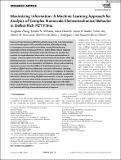Maximizing information : a machine learning approach for analysis of complex nanoscale electromechanical behavior in defect-rich PZT films
Abstract
Scanning Probe Microscopy (SPM) based techniques probe material properties over microscale regions with nanoscale resolution, ultimately resulting in investigation of mesoscale functionalities. Among SPM techniques, piezoresponse force microscopy (PFM) is a highly effective tool in exploring polarization switching in ferroelectric materials. However, its signal is also sensitive to sample-dependent electrostatic and chemo-electromechanical changes. Literature reports have often concentrated on the evaluation of the Off-field piezoresponse, compared to On-field piezoresponse, based on the latter's increased sensitivity to non-ferroelectric contributions. Using machine learning approaches incorporating both Off- and On-field piezoresponse response as well as Off-field resonance frequency to maximize information, switching piezoresponse in a defect-rich Pb(Zr,Ti)O3 thin film is investigated. As expected, one major contributor to the piezoresponse is mostly ferroelectric, coupled with electrostatic phenomena during On-field measurements. A second component is electrostatic in nature, while a third component is likely due to a superposition of multiple non-ferroelectric processes. The proposed approach will enable deeper understanding of switching phenomena in weakly ferroelectric samples and materials with large chemo-electromechanical response.
Citation
Zhang , F , Williams , K N , Edwards , D , Naden , A B , Yao , Y , Neumayer , S M , Kumar , A , Rodriguez , B J & Bassiri-Gharb , N 2021 , ' Maximizing information : a machine learning approach for analysis of complex nanoscale electromechanical behavior in defect-rich PZT films ' , Small Methods , vol. Early View , 2100552 . https://doi.org/10.1002/smtd.202100552
Publication
Small Methods
Status
Peer reviewed
ISSN
2366-9608Type
Journal article
Description
F.Z. and B.J.R. gratefully acknowledge support from the China Scholarship Council and Science Foundation Ireland (US-Ireland R&D Partnership Programme (SFI/14/US/I3113) and Career Development Award (SFI/17/CDA/4637) with support from the Sustainable Energy Authority of Ireland). A.N. gratefully acknowledges support from the Engineering and Physics Sciences Research Council (EPSRC) through grants EP/R023751/1 and EP/L017008/1. A.K. gratefully acknowledges support from Department of Education and Learning NI through grant USI-082 and Engineering and Physical Sciences Research Council via grant EP/S037179/1. K.W., Y.Y., and N.B.G. gratefully acknowledge support from the US National Science Foundation through grant CMMI-1537262 and DMR-1255379. K.W. and N.B.G. also acknowledge support through DMR-2026976. This publication has emanated from research supported in part by a grant from Science Foundation Ireland under Grant numbers SFI/14/US/I3113 and SFI/17/CDA/4637.Collections
Items in the St Andrews Research Repository are protected by copyright, with all rights reserved, unless otherwise indicated.

